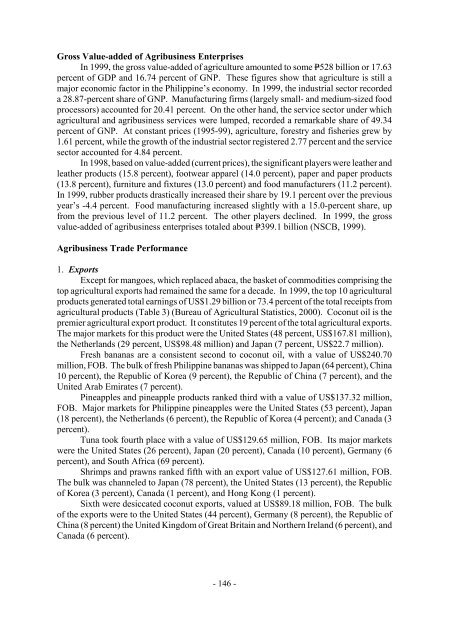Development of Agribusiness Enterprises - Asian Productivity ...
Development of Agribusiness Enterprises - Asian Productivity ...
Development of Agribusiness Enterprises - Asian Productivity ...
Create successful ePaper yourself
Turn your PDF publications into a flip-book with our unique Google optimized e-Paper software.
Gross Value-added <strong>of</strong> <strong>Agribusiness</strong> <strong>Enterprises</strong><br />
In 1999, the gross value-added <strong>of</strong> agriculture amounted to some P=528 billion or 17.63<br />
percent <strong>of</strong> GDP and 16.74 percent <strong>of</strong> GNP. These figures show that agriculture is still a<br />
major economic factor in the Philippine’s economy. In 1999, the industrial sector recorded<br />
a 28.87-percent share <strong>of</strong> GNP. Manufacturing firms (largely small- and medium-sized food<br />
processors) accounted for 20.41 percent. On the other hand, the service sector under which<br />
agricultural and agribusiness services were lumped, recorded a remarkable share <strong>of</strong> 49.34<br />
percent <strong>of</strong> GNP. At constant prices (1995-99), agriculture, forestry and fisheries grew by<br />
1.61 percent, while the growth <strong>of</strong> the industrial sector registered 2.77 percent and the service<br />
sector accounted for 4.84 percent.<br />
In 1998, based on value-added (current prices), the significant players were leather and<br />
leather products (15.8 percent), footwear apparel (14.0 percent), paper and paper products<br />
(13.8 percent), furniture and fixtures (13.0 percent) and food manufacturers (11.2 percent).<br />
In 1999, rubber products drastically increased their share by 19.1 percent over the previous<br />
year’s -4.4 percent. Food manufacturing increased slightly with a 15.0-percent share, up<br />
from the previous level <strong>of</strong> 11.2 percent. The other players declined. In 1999, the gross<br />
value-added <strong>of</strong> agribusiness enterprises totaled about P=399.1 billion (NSCB, 1999).<br />
<strong>Agribusiness</strong> Trade Performance<br />
1. Exports<br />
Except for mangoes, which replaced abaca, the basket <strong>of</strong> commodities comprising the<br />
top agricultural exports had remained the same for a decade. In 1999, the top 10 agricultural<br />
products generated total earnings <strong>of</strong> US$1.29 billion or 73.4 percent <strong>of</strong> the total receipts from<br />
agricultural products (Table 3) (Bureau <strong>of</strong> Agricultural Statistics, 2000). Coconut oil is the<br />
premier agricultural export product. It constitutes 19 percent <strong>of</strong> the total agricultural exports.<br />
The major markets for this product were the United States (48 percent, US$167.81 million),<br />
the Netherlands (29 percent, US$98.48 million) and Japan (7 percent, US$22.7 million).<br />
Fresh bananas are a consistent second to coconut oil, with a value <strong>of</strong> US$240.70<br />
million, FOB. The bulk <strong>of</strong> fresh Philippine bananas was shipped to Japan (64 percent), China<br />
10 percent), the Republic <strong>of</strong> Korea (9 percent), the Republic <strong>of</strong> China (7 percent), and the<br />
United Arab Emirates (7 percent).<br />
Pineapples and pineapple products ranked third with a value <strong>of</strong> US$137.32 million,<br />
FOB. Major markets for Philippine pineapples were the United States (53 percent), Japan<br />
(18 percent), the Netherlands (6 percent), the Republic <strong>of</strong> Korea (4 percent); and Canada (3<br />
percent).<br />
Tuna took fourth place with a value <strong>of</strong> US$129.65 million, FOB. Its major markets<br />
were the United States (26 percent), Japan (20 percent), Canada (10 percent), Germany (6<br />
percent), and South Africa (69 percent).<br />
Shrimps and prawns ranked fifth with an export value <strong>of</strong> US$127.61 million, FOB.<br />
The bulk was channeled to Japan (78 percent), the United States (13 percent), the Republic<br />
<strong>of</strong> Korea (3 percent), Canada (1 percent), and Hong Kong (1 percent).<br />
Sixth were desiccated coconut exports, valued at US$89.18 million, FOB. The bulk<br />
<strong>of</strong> the exports were to the United States (44 percent), Germany (8 percent), the Republic <strong>of</strong><br />
China (8 percent) the United Kingdom <strong>of</strong> Great Britain and Northern Ireland (6 percent), and<br />
Canada (6 percent).<br />
- 146 -
















